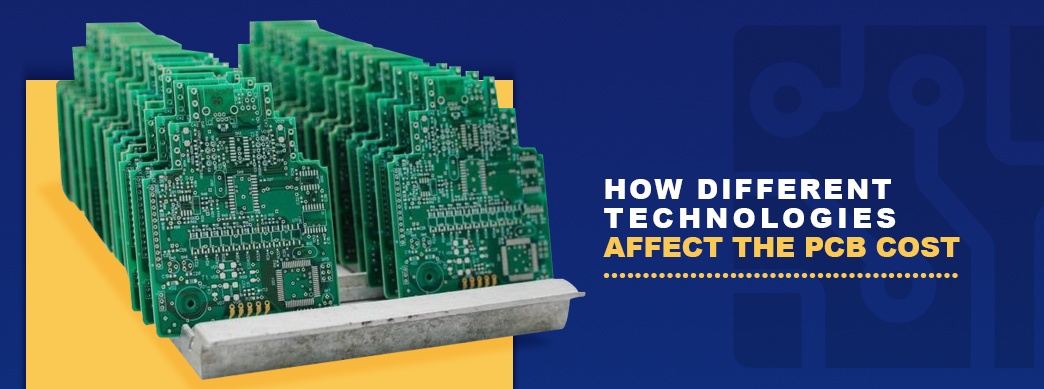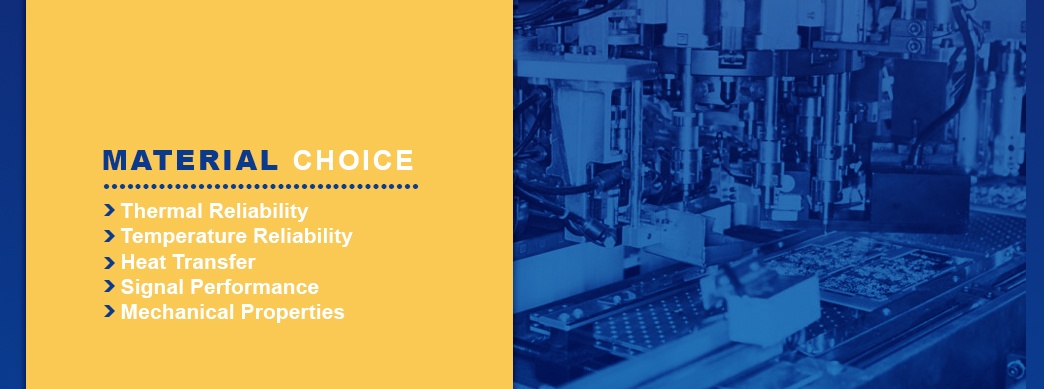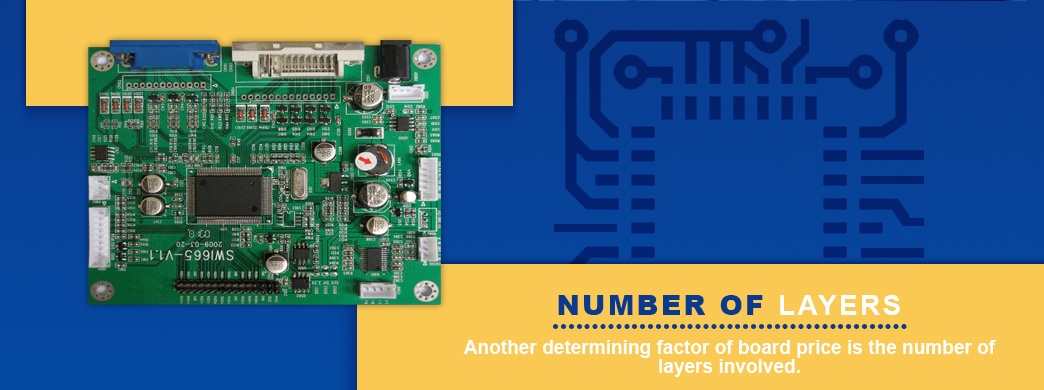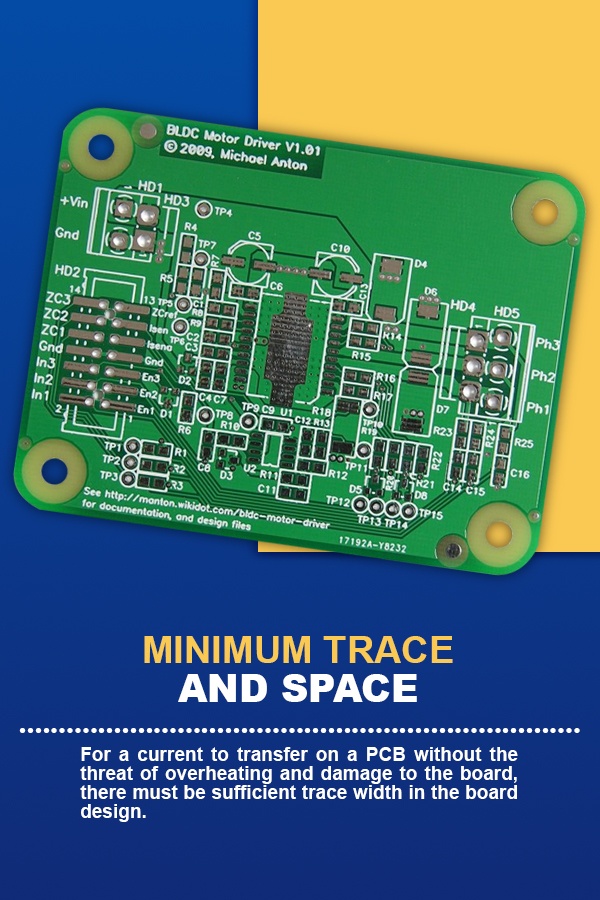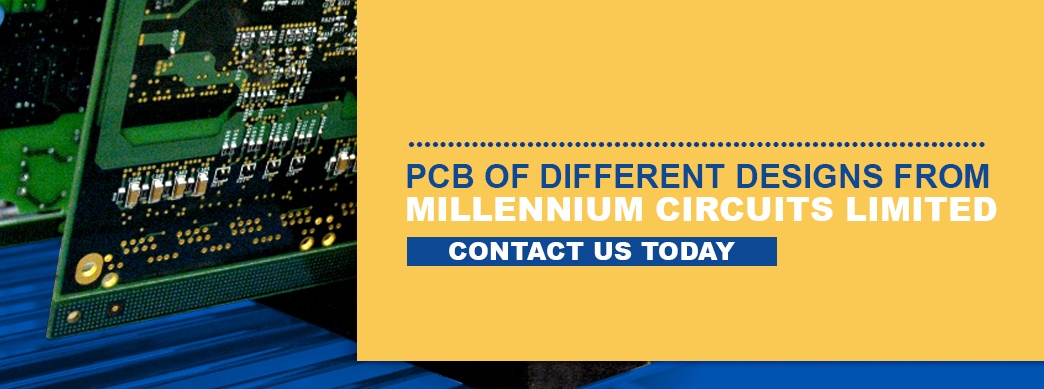Jump To: Factors That Affect PCB Cost | Material Choice | PCB Size | Numbers of Layers | Finish (ENIG, HASL, etc.) | Size of Hole | Minimum Trace and Space | The Thickness and Aspect Ratio | Custom or Unique Specifications | PCB of Different Designs
PCB technologies involve high levels of intricacy. Depending on the design of a circuit board, its production could be more or less costly than the average PCB. If a PCB is intended for an everyday conventional item, the cost to manufacture the board itself should be significantly lower than the price of a board designed for high-tech machinery.
Factors That Affect PCB Cost
The three factors that most impact PCB manufacturing cost breakdown are the type of material, the size of the board and the number of layers. Other factors that can also impact price include the finish and the size of the holes, including these eight.
1. Material Choice
The materials used in a circuit board will invariably affect its cost. Standard PCBs are laminated with FR4 material, but this will not suffice for boards manufactured for high-intensity uses, such as those common in the aerospace and fuel industries.
The factors that can impact material selection include:
- Thermal Reliability: Will the board be capable of performing under the range of temperatures expected for the tasks in question? Certain boards require materials of a higher thermal rating than standard boards.
- Temperature Reliability: Can the material withstand an expected range of atmospheric conditions within a controlled setting without overheating? PCBs intended for high-temperature working operations require materials that pass these tests.
- Heat Transfer: Will the board withstand high-intensity loads without transferring undue levels of heat to attached and adjacent components? The right material will need to pass this test for the uses in question.
- Signal Performance: Will the material facilitate uninterrupted electrical signals throughout each operating cycle of a given machine? Will the signal withstand a necessary range of temperatures and other environmental factors? These concerns are integral to the performance of a PCB.
- Mechanical Properties: Does the material have sufficient physical composition to withstand a plausible range of physical stresses? Can the board be pressed into a tight slot without cracking? Can it be dropped several feet without breaking? Any PCB ideal for sale will need to pass drop tests and other performance criteria.
As a rule of thumb, operations that involve higher frequencies require materials of a higher grade than standard FR4. As such, the materials used in a microwave PCB could be 10 times more costly than the materials used for the board in a calculator or other handheld device.
2. PCB Size
The size of a PCB and its panel utilization are two of the most crucial factors that affect the price. The size of a board will generally be determined by the number of circuits required for the corresponding device.
A PCB in something as small as a digital watch will require fewer components and ultimately be less costly to produce than a computer or laptop PCB. Likewise, the PCB in a large piece of industrial machinery will be larger than the boards contained in most home electronics.
In PCB manufacturing, the following dimensions are among the most common:
- 18 X 24″ (457 x 610mm)
- 18 X 21″ (457 x 533mm)
- 21 X 24″ (533 x 610mm)
The amount of space consumed by components on a board will also affect the price. Granted, some boards are designed with less consideration of efficiency and production costs.
For example, an 18 x 24 PCB that contains three columns and two long rows of panel utilization would be an efficient use of board space because active components will consume the majority of the overall panel. On the other hand, an 18 x 24 PCB that contains one column and three rows would be less efficient because the margins will be wider, yet still costly due to the material.
Ultimately, the dimensions of your PCB design will be one of the main determining factors of the overall price. Even if you manufacture a small PCB at high volume, the total cost might be less than that of a low-volume, large PCB.
3. Number of Layers
Another determining factor of board price is the number of layers involved. For obvious reasons, PCBs with three or more layers cost more to produce than boards that consist of merely two layers. The pricing issue is affected by the types of material used and the size of the board itself. Overall, thick boards with numerous layers require considerably more work to manufacture.
Overall, price increases on a layer-by-layer basis can be broken down as follows:
- 1L to 2L: 35 – 40%
- 2L to 4L: 35 – 40%
- 4L to 6L: 30 – 40%
- 6L to 8L: 30 – 35%
- 8L to 10L: 20 – 30%
- 10L to 12L: 20 – 30%
Some of the most significant increases in manufacturing cost occur once a second layer is added to a board. From there, an additional two boards will raise the cost by at least one-third of the previous price. The price increases are generally less steep once a design crosses the eight-layer threshold.
With each layer added to a PCB, more production steps are involved in the lamination process. This requires more time to achieve and necessitates a larger supply of material. The steps involved in multi-layer board construction also increase the possibility of production defects. To offset the possible cost of errors, PCB makers will often factor this into quotes on multi-layer board production.
Depending on the material used in a board design, you might need more layers to ensure a solid composition. If a PCB is expected to endure a high amount of stress and still have a certain degree of flexibility, these factors will largely determine the layer count, as well as the material.
4. Finish (ENIG, HASL, etc.)
A minor factor to consider regarding PCB production involves the costs associated with a given finish. Some finishes boast higher grades and offer longer shelf life, thus adding to the overall cost of production. One of the more common and low-cost surface treatments is HASL, which offers good solderability but is rated unfavorably on other counts. ENIG, by comparison, scores favorably in most categories yet only commands a slight price difference.
Each of the surface treatment options offers unique features:
- HASL: Solderability
- LFHASL: Solderability
- OSP: Solderability
- IMM Ag: Solderability, Al wire bondable
- IMM Sn: Solderability
- ENIG: Solderability, Al wire bondable, contact surface
- ENEPIG: Solderability, Al wire bondable, contact surface
- Elec Au: Solderability, Al/Au wire bondable, contact surface
The number of layers may also determine whether the finish impacts the price of PCB production to a significant degree.
5. Size of Hole
One of the important, if not crucial, factors that can influence the cost of a PCB production is the size of the holes in a board. The costs associated with holes can also be determined by the number of holes required for the board, as well as the type of material and thickness of layers being drilled. Overall, more holes require more work, especially if the holes in question are challenging to drill due to tininess and board thickness.
The sizes of the holes in a board design are the most crucial price determinants in this area. If the holes are super-thin, they will require special tools to produce. For example, a hole that has the diameter of a hair strand will be more challenging to create than a hole that equals the diameter of a typical screw hole. Such holes require more work and a specialized skill set to accomplish.
Whether the holes are regularly sized or microscopic, the price of the board production can also be impacted by the number of holes contained in a given design. If a board contains dozens of holes, this feature will be added on to the price due to the extra work involved.
Additional hole-related factors that can impact the price of a PCB production are the thickness of the material and the number of layers contained in the board design. If a board consists of 10 or more layers, hole-drilling will be a more time-consuming task due to the thickness. If the material is super-strong and hard to drill, this will also impact the price.
6. Minimum Trace and Space
For a current to transfer on a PCB without the threat of overheating and damage to the board, there must be sufficient trace width in the board design. On boards of all sizes, a simple correlation exists between the trace width and carrying capacity. A section of the former will determine the latter. Moreover, trace cross-sections correlate to the thickness of copper.
It must be noted that trace carrying capacity does not necessarily correspond to the cross-section space. In fact, the amount of current that a trace can hold, at maximum, cannot be easily calculated, regardless of the trace width or temperature rise. The carrying capacity of a current can also be impacted by pads, vias and other board elements.
On a board with numerous pads, you might encounter a trace of exceptional capacity. If this is not accounted for in the soldering process, an excessive cross-sectional area might be created, and transient surges are liable to occur.
To avoid these situations, board makers will enlarge the trace width, if possible. Alternately, they can add extra solder mask to the traces that might otherwise be prone to burn. These steps can add to the price of a PCB production.
7. The Thickness of the PCB and Aspect Ratio
Until recently, the thickness of a PCB had played only a minor role in the overall cost, though all that is liable to change in the coming years. Thicker material can be costlier to procure, laminate and form into a printed circuit board, especially if the design itself is highly intricate.
Thinner material will generally put a line of PCBs into a slightly lower cost bracket because less material is required for the production at hand. The costs of a board in regards to thickness can also be impacted by the type of material used in a given production.
The standard thickness for a PCB is 1.6mm (0.063″). In recent times, thicker boards have become more expensive, though an industry-wide going rate has never been established. Overall, it depends on the manufacturer whether a thinner board of 0.8 mm will cost less or equal to a board of standard thickness.
The price of a thicker board could be significantly higher if it also has a larger aspect ratio. If the board consists of multiple layers for its thickness and features wide dimensions, the board will require more material and involve more work in its construction. Therefore, it might not be the thickness of the board that impacts the cost as much as the measurements or the number of layers that add to the thickness.
8. Custom or Unique Specifications
PCB manufacturing costs can also be impacted by the unique design elements in a given production. If you come to a PCB maker with custom specifications, this could raise the cost of its production, even if the board itself is small and consists of only one or two layers. The real determining factor in this regard will be whether the features in question require special tools or skills to achieve. Examples of custom specifications could include:
- Contoured Edges: PCBs with rounded edges could cost more to produce, especially those that require z-axes routing.
- Side-Plating: Some PCB designs specify metal edges for boosted EMC strength.
- Solder Mask Clearance: If extra clearance and thickness are needed of the solder mask, this will increase costs.
Special features require specialized skill sets. If your design involves details that are hard to produce and are not the types of details that PCB makers assemble on a regular basis, this could limit the number of people who could work on the production. This, in turn, could lead to a more time-consuming production. If the overall production takes additional hours to finish, your boards will cost more in the end.
Special tools are often required for unique board designs. If the board requires numerous holes in some unusual size that does not match one of the standard diameters, the company that handles your order might need to procure the necessary instrument and charge you for the costs involved. Alternately, you might be asked to supply the tools required for a special design request. These are agreements that should be stipulated in advance of any contract with a PCB maker.
To avoid exceptionally high costs that might stem from unique PCB design requests, calculate the potential price of your design in before production. Determine the custom specifications of the design and the steps required to bring it to fruition. Make sure these details are understood by the PCB maker to avoid costly trial and error.
PCB of Different Designs From Millennium Circuits Limited
PCB material properties can significantly impact the cost of assembly, as can the size of the board and the number of layers involved. To keep costs at a reasonable level, it’s always best to make a PCB materials comparison beforehand to see what will work best for your design.
At Millennium Circuits, we work with each customer to ensure they get the boards they need, the way they need them. Contact us today for a quote for your specifications.


